
How’s the weather on Oahu in spring, summer, winter and fall? Temperatures are pleasantly warm all throughout the year.
Let’s dive into all the Oahu weather details including temperatures, rainfall, microclimates and more.
Average Oahu Temperatures
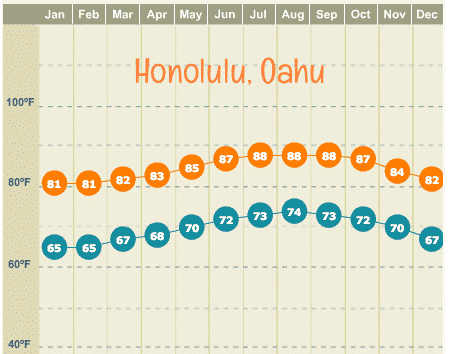
The above chart indicates the average monthly temperatures for Honolulu, Hawaii. It’s a good representation for the rest of the beach resorts on the island. (Note that anytime, you are in a higher elevation, for example at the popular Pali Lookout, temperatures will be chillier.)
As you can see from the chart, Oahu’s average high temperature ranges from the low to upper 80s F. The “coolest” months – at a lovely 81 F – are January and February. The hottest months are July, August and September with an average of 88 F. (To convert temperatures to Celcius, use this link.)
Evening temperatures in winter and spring months dip down to the mid to upper 60s. If you’re outside past sunset, you might want to have a light sweater or jacket with you. Summer and fall average low temperatures are pleasant in the lower 70s.
Oahu Rainfall Data
Just as we mentioned in the Kauai weather guide, it’s important to note that in Hawaii, most rain falls overnight when you’ll be sleeping rather than sightseeing. That being said, it’s possible that you might encounter some rain, particularly during the wetter winter months. Most rain showers are brief. If you encounter a rainy day, check out our list of fun things to do during rain on Oahu.
Even though winter months tend to be a little wetter, we wouldn’t hesitate to book a Hawaii vacation in the winter. In fact, we tend to go to Hawaii quite often in the winter and it’s been very rare that we’ve encountered rain. We’ve never had a full day that was a complete rainout.
Rain in Hawaii brings some benefits that we tourists enjoy. Rain makes the pretty waterfalls flow. (Note that some waterfalls dry up or are only a trickle after a dry summer.) The rain makes Hawaii’s delicious produce grow and the flowers bloom.
If you have further concerns about rain, read our article — will it rain on my Hawaii vacation?
The following chart shows the average monthly rainfall levels based on data collected from the Honolulu airport. As you can see, the driest months range from April through September. Fall and winter months bring more precipitation to the islands, which also makes the island greener. For example, see how much greener Diamond Head looks in winter as compared to the end of summer in this post.

Another point to note about the above rainfall chart is that the significant increase in rainfall between February and March is partially due to the fact that March has more days than February. When we further investigated it, rainfall levels in March were still slightly higher in March as compared to February, which is not as dramatic as the chart appears at first glance.
As we look at the seasonality of Oahu rainfall levels, we should also consider the microclimates of the island. Some areas are wetter than others.

In conjunction with the above rainfall map, also look at the following Google Map of Oahu noting that the darker green areas are also the areas that receive the most annual precipitation. This area is called the windward side. Likewise, the lighter green and tan regions are drier. The drier areas are called the leeward side.
As you review these maps while choosing where to stay on Oahu, notice that two of the larger areas with hotels on a beach — Honolulu/Waikiki and Ko Olina are in the driest regions. The North Shore gets slightly more annual precipitation, but we wouldn’t really let that deter us from visiting the North Shore — even in the rainiest months. If you are having difficulty trying to decide whether to stay in one of the drier areas versus a greener, more lush environment, you may want to split your time between two different regions.
Ocean Temperature around Oahu
You can swim and enjoy water sports year round in Hawaii. Water temperatures near Honolulu range from 76F in winter months to 81F in late summer and early fall. The following graph shows the average water temperature by month for Honolulu. For more information see our detailed article about Hawaii ocean temperatures.

Oahu Humidity
The relative humidity for Honolulu averages around 64%. That may seem uncomfortably high, but when the tradewinds blow, which they do most of the time, that breeze keeps you comfortable. See the Honolulu chart on this page for more humidity details.
Besides relying on the tradewinds, you can do a couple of things to help you feel more comfortable in the humidity. First, we recommend you stay in an accommodation that has ample air conditioning. Last year, some of our friends stayed in a condo in Hawaii that had one, small air conditioning unit that wasn’t large enough to properly cool the entire condo. They were uncomfortable for several days. The other tip to combat humidity is to wear breathable, light clothing.
Oahu Hurricane Season
Though Hawaii is currently experiencing a busy tropical storm season in 2015, that has thankfully skirted around the islands, hurricane season is normally a non-factor in Hawaii. Hurricane season runs from June through November with the months of August and September historically being the most active.
—
Have you been to Oahu? What time of year did you go? How was the weather?
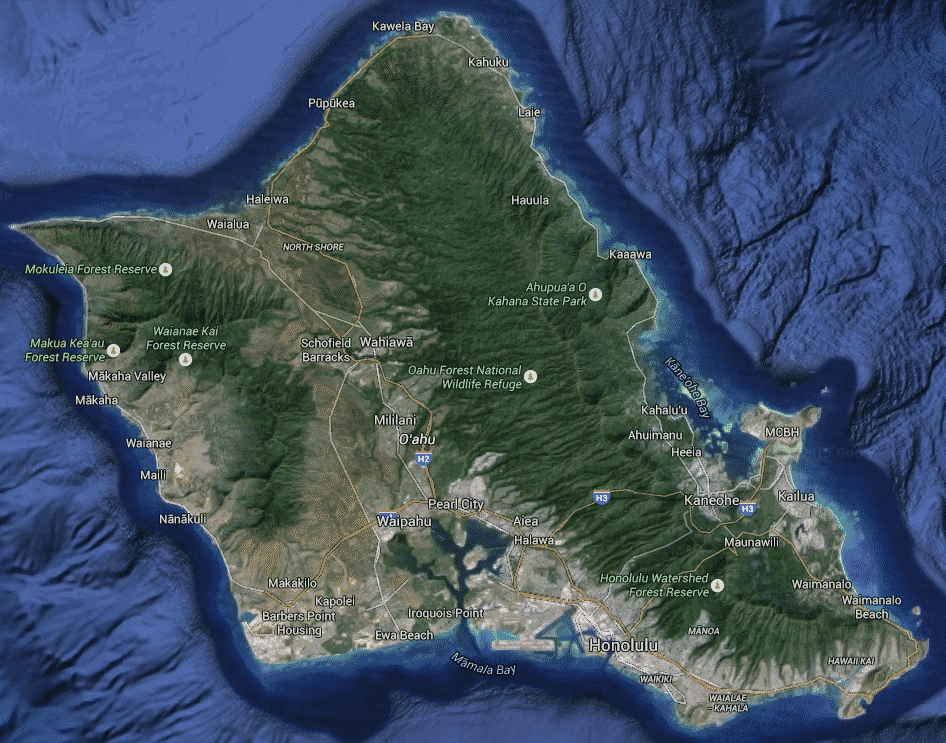

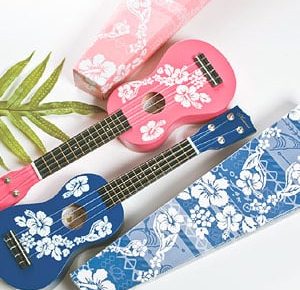
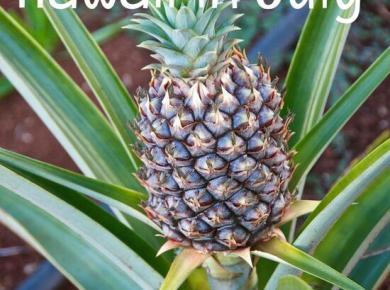
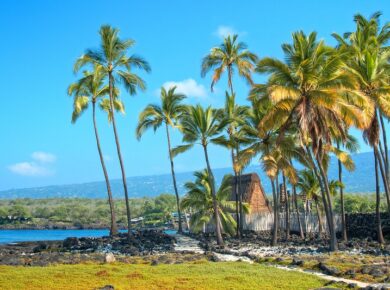
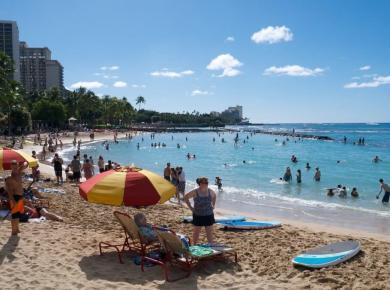
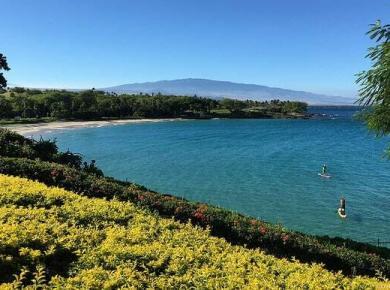
13 comments
We went in August (2014) and, luckily, missed the bad weather from back-to-back hurricanes by one week!! The weather was warm (88 degrees) and humid but it’s that way in my home state of Michigan too so it wasn’t a particular concern. As you stated, nice trade winds to help make it more pleasant…that and being in PARADISE!! We’re returning this August, again staying at the Hilton Hawaiian Village. It’s such a nice resort with EVERYTHING you need right there. I can’t wait to return and share it with my 6-1/2 year old grandson who we’re taking along. His older brother got a great trip to Alaska last year and his younger brother wouldn’t appreciate it quite yet. (The amount of travel time with the 4-year old wouldn’t be good either.) I appreciate all your great advice on this site!! So helpful and, what I’ve read, has been on point to what I experienced on my first visit!! Thank you!
Please let me know the sunrise and sunset time at Honolulu in end of Jan.
https://govisithawaii.com/2011/11/30/what-time-is-sunset-in-waikiki/
planning to go in January… want lot’s of sun andnot a lot of rain, is that about right that time of year?
Rainfall patterns are discussed in detail in the article.
planing to go to honolulu in December…is a good time of the year?
Read this: https://govisithawaii.com/2014/11/05/is-december-a-good-month-for-vacation-in-hawaii/
We have booked a trip with a few families this upcoming Dec/Jan staying in Honolulu. Any ideas for NYE – something child friendly? Will you be doing a similar write up from last year ?
In December. It will be updated here: https://govisithawaii.com/waikiki-honolulu-oahu-new-years-eve-fireworks-dining-events/
North Shore Oahu March 6, 2018 – March 16, 2018. So far had no sun and it is very windy: 32 mph gusts. The forecast does not look promising. We are rather disappointed with the weather gods as this is our first time to Oahu and it is not leaving us with wanting to come back.
We were in Oahu the same time period. We have gone several years for spring break and this was our first year to have rain most of the week. Very disappointing. Many locals said it had been raining for weeks! Hoping for more sun this year!
Thanks for sharing your experience. We hope you see more sunny skies on your next trip. Please let us know how it goes.
We went in November 2018 and weather was perfect, had maybe 5 minutes rain each day but the cloud cover felt great, went snorkeling in the rain one day, we will definitely return!